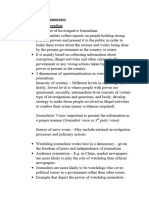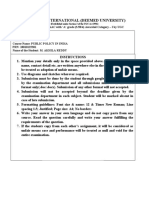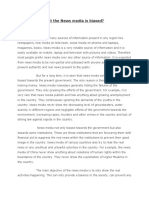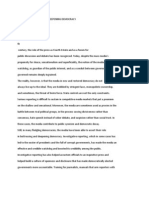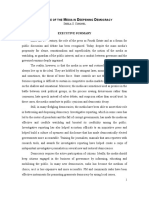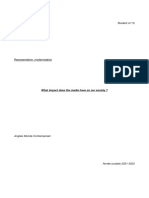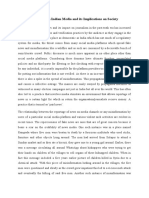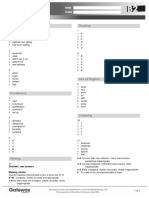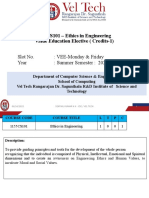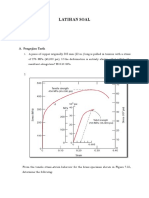YELLOW JOURNALISM: MODULE-6
Yellow journalism refers to the biased and fake news spread by the TV news channel, social media
profile, newspaper and video in social media. Biased news is the news which supports a political
party, a particular community or idealism. Fake news is also spread for supporting a particular
political party.
Journalism refers to a profession which disperses information among people about the incidents
occurring around the earth. The media is considered as “the fourth pillar” of democracy.
The term “yellow journalism” was first coined by two famous journalists named William Randolph
Hearst and Joseph Pulitzer. This term involves fake information and false news along with a large
number of tattles, scandals and “sensationalism”. Some years ago, these fake news and erroneous
information were frequently not corrected. Therefore, many people did not get the chance to know
the truth and they remained “ill-informed”.
“Yellow journalism” utilizes some traits like terrific headlines in large print, utilization of
misinformation, “pseudoscience” and fake news, utilization of sumptuous images and fake
interviews. At first people trusted all information provided by “yellow journalism”, but now most
people become cautious about its falsity.
For the news channel in India, the public mostly uses two terms to identify all the news media in two
different divisions of ideology. These are ‘Liberal media’ and ‘Godi media’. ‘Liberal media’ talks
against the government and ‘Godi media’ supports the government. Capitalism, democracy and
rights of people are supported by the liberal media. Erroneous news and fake stories are circulated
by the Godi media. This media is considered as the mouthpiece of the ruling government in India.
Biased media has become threat to democracy. The biased media also talks about steps and policies
of government that can never be wrong. News has been continuously filtered by media houses. In
current years, media houses have lost their critical power to disseminate between erroneous news
and actual news. Media plays an important role in establishing democracy but because of
misinformation and fake news, people are straying away from the true facts and events.
Examples: Fake News 4: After the release of the new two thousand rupee note, a fake news was run
by some reputed news channels that a GPS enabled microchip is attached with the note to track the
location of the note.
Fake News 7: Several fake news had gone viral in the social media about what UNESCO thinks about
India. This fake news was such as, UNESCO declares Narendra Modi as the best Prime Minister,
UNESCO declares the national anthem of India as the best national anthem and the Rs 2000 note as
the best currency in the world.
Why to address this issue?
Erodes trust in media: When sensationalized stories and fabricated information are
presented as news, it erodes public trust in all media. This makes it harder for people to
distinguish real news from fiction.
Fuels polarization: Yellow journalism often thrives on stirring emotions and exaggerating
differences. This can exacerbate social and political divisions, hindering productive
discourse.
�Hinders informed decision-making: When people are misled by biased or false information,
they can't make informed decisions on important issues. This can have consequences for
everything from elections to public health.
Undermines democracy: A healthy democracy relies on an informed citizenry. Yellow
journalism weakens this foundation by manipulating information.
CITIZEN REPORTERS AND SOCIAL MEDIA:
A citizen reporter, also known as a citizen journalist, is someone who reports news and
information without being a professional journalist for a traditional media outlet. They
typically use online platforms like social media, blogs, or podcasts to share their stories and
perspectives.
Citizen reporters can play an important role in bringing awareness to local issues and events,
especially in situations where traditional media coverage is limited. For instance, they might
provide firsthand accounts of disasters or protests through text messages and videos.
Negative aspects:
Misinformation and Bias: Anyone can post on social media, and there's no
guarantee of accuracy. Citizen reports might be based on personal opinion, limited
information, or even be fabricated entirely.
Sensationalism: Social media rewards attention-grabbing content. This can
incentivize citizen reporters to exaggerate or dramatize events to get more views and
shares.
Privacy Concerns: In the rush to share information, citizen reporters might
inadvertently capture people on video or reveal personal details without their consent.
Here are some ways to address these issues:
Media Literacy: Educating the public on how to evaluate information online is
crucial. People need to be able to critically assess the source, content, and potential
bias of citizen reports.
Fact-Checking Initiatives: Encouraging fact-checking platforms and tools can help
verify the accuracy of information circulating on social media.
Social Media Responsibility: Holding social media platforms accountable for
tackling misinformation and fake news is important. This can involve implementing
measures to flag suspicious content and promoting responsible sharing practices.






